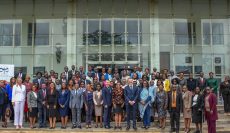In the heart of the savannah, where the Maasai Mara’s lions roar and the vibrant hues of the Great Rift Valley paint the landscape, a different kind of roar is emerging, one that is gaining consistent momentum. Welcome to Kenya, where disputes meet resolution not only in courtrooms, but also under the vast African sky, through Alternative Dispute Resolution (ADR) (Article 159 (Constitution of Kenya), 2010).
Imagine a land where disputes are not just seen as battles to be fought, but also as opportunities for fostering understanding and growth. This is the spirit of ADR, a method of resolving disputes that transcends the rigidity of legal battles (Stražišar, 2018). In a country where communal bonds are strong, ADR is a solution where disputing parties come together to find unity, togetherness, confederation; even amidst conflict (Baum, 2010).
However, what exactly is ADR? Simply put, it encompasses all methods other than litigation that are utilized to resolve conflicts between individuals or entities. . They include, but are not limited to: negotiation; enquiry; mediation; conciliation; expert determination; and arbitration (Muigua F. K.,). In the range of ADR techniques, Kenya embraces a spectrum of options, from mediation to arbitration, negotiation to conciliation, and even Traditional Dispute Resolution Mechanisms (TDRM’s). These techniques are not mere legal jargon; they are the colour that cover the canvas of dispute resolution in Kenya.
In Kenya, and more so in the recent years, there has been an extraordinary rise in the choice of pursuing ADR, as opposed to litigation. This method has proven to take a much shorter time, greatly reducing the backlog in Kenyan courts (Muigua F. K., 2014). In this piece, we seek to introduce ADR in the Kenyan context; and reaffirm the importance of this mechanism in the sphere of dispute resolution.
Meat in the Mara: The Delicate Balance of Dispute and Justice
Venture into the Maasai Mara, and you will witness a conflicting dance of lions and zebras. Each animal knows its day will come. The lion will hunt; the zebra will be hunted–a dispute as old as the African savannah itself. The universe calculates and in its quintessential cruelty and reality, assigns a zebra to a lion. Only then does the wild maintain its balance. ADR, in its essence, mirrors this tango, striving to restore balance and harmony in the face of conflict. Except, in ADR, unlike in instances where the universe pre-decides the fate of the zebra, humans consciously choose the route to navigate their dispute, in a controlled manner. In fact, this is what makes ADR appealing – the level of choice and control, commonly referred to as party autonomy (Lipsky, 1997).
Legal battles can be as daunting as the battle between the crocodiles and the wildebeests that cross the Mara River during the Great Migration, in addition to the risk of being swept away by the strong currents of the river, in terms of time and expenses.
ADR, on the other hand, is a bridge, a pathway across the legal river that allows parties to traverse with a shared commitment to finding resolution rather than drowning in the adversarial waves.
From Nairobi’s Skylines to Mombasa’s Shores: ADR’s Reach Across Kenya
ADR is not confined to the urban jungles of Nairobi; its roots run deep, reaching the shores of Mombasa and the slopes of Mount Kenya. In bustling markets, serene villages, and coastal towns, ADR is not just a legal process – it is a cultural legacy passed down through generations. Kenya is a country that has opened its doors to varied methods of dispute resolution, taking into consideration the rich history of the Kenyan people. An example of this is the incorporation of Traditional Dispute Resolution Mechanisms (TDRMs), a type of ADR. This is indicative of this stride to be inclusionary (Muigua K., 2018).
In Lamu’s narrow alleys, disputes find their resolution through the process of Alternative Dispute Resolution (ADR). Here, elders, reminiscent of ancient poets, engage in crafting narratives of creative judgment, akin to the poetic echoes of Swahili poetry resonating in the surroundings. These narratives serve as solutions, mirroring the scenic beauty of the coastal landscapes. ADR, therefore, becomes the embodiment of a collaborative journey towards resolution. The disputing parties, guided by principles of good faith, navigate a joint ascent to the peak of goodwill. This metaphorical climb emphasizes cooperation rather than rivalry, painting a picture of harmonious resolution in the shadow of Mount Kenya, where ADR acts as a forum for reaching agreements that are not only legally sound but also culturally enriched and in tune with the local environment. This is the spirit of ADR: widening access to justice for all (Njiri, 2020).
Conclusion
As the sun sets on the Kenyan horizon, painting the sky in hues of orange and purple, ADR stands tall as a symbol of harmony and resolution. From the bustling cityscape of Nairobi to the tranquil shores of Lake Victoria, ADR is everywhere; and is growing in popularity.
In the spirit of Ubuntu, an ideology that supports collectivism rather than individualism, Kenya has embraced ADR, not just as a legal process, but as a cultural philosophy – a way of resolving disputes that honours the interconnectedness of communities and the African spirit of “I am because you are”-one people with a shared destiny. In the quintessential spirit akin to Maat, the personification of truth, order and justice, ADR restores balance and justice, ensuring that disputes do not become raging rivers but manageable streams.
So, the next time a dispute arises under the African sky, remember the lessons from Kenya – the land where disputes are not battles to be won but opportunities to strengthen and unify relations, conducted under the vast expanse of the Kenyan sky.
Works Cited
Muigua, F. K. (2014). ADR, Access to Justice and Development in Kenya. Strathmore Annual Law Conference, 1.
Baum, C. (2010). The benefits of alternative dispute resolution in common interests development disputes. Johns Law Review, 907.
Stražišar, B. (2018). Alternative Dispute Resolution. Journal of the Higher School of Economics, 214.
Lipsky, D. B. (1997). In search of control: The corporate embrace of ADR. University of Pennsylvania journal of labor and employment law, 139.
Njiri, K. N. (2020). Alternative Dispute Resolution and Access to Justice: The Kenyan Perspective. SSRN, 1-8.
Muigua, K. (2018, August). Traditional Dispute Resolution Mechanisms Under Article 159 of the Constitution of Kenya 2010. Kariuki Muigua & Company Advocates.
Article 159 (Constitution of Kenya) (2010).
This article was written by Esther Njue & Zayn Aslam





